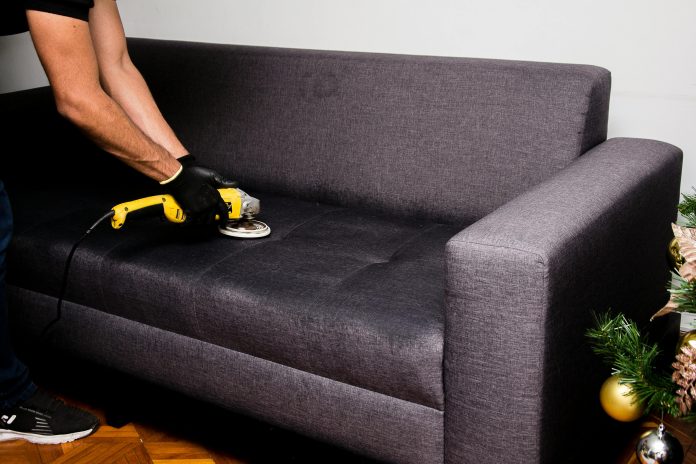There’s nothing quite like sinking into your favourite armchair at the end of a long day—unless, of course, that armchair looks damaged and worn out.
Cleaning your upholstery sounds simple enough, but it’s surprisingly easy to turn a quick refresh into a full-blown fabric disaster. From using the wrong sprays to drowning your couch in detergents, these slip-ups are more common than you’d think.
Here’s how you can steer clear of the biggest blunders and keep your furniture looking sharp, comfy, and guest-ready.
1. Skipping Pre-Cleaning Preparation
Diving straight into cleaning without a bit of preparation can make the job harder than it needs to be. Dust, crumbs, and loose debris left on the surface often get pushed deeper into the fabric during cleaning, which only adds to the problem.
Start by clearing the area. Remove cushions, throws, or anything else that might be in the way. Then run a vacuum with a soft brush attachment over the upholstery to lift away surface dirt.
This quick step makes cleaning easier and helps you notice things you might’ve missed, like a loose stitch or a sneaky stain hiding under a cushion.
A little prep goes a long way, and before you start scrubbing, it’s worth checking what your upholstery can actually handle. That brings us to the next step: following the manufacturer’s instructions.
2. Ignoring Manufacturer Instructions
Before you grab the cleaning spray, take a look at that small tag hiding under the cushion. It’ll tell you exactly how your sofa wants to be cleaned.
Some fabrics can handle water-based cleaning, while others need a gentler, dry-cleaning approach or even a professional touch.
Overlooking these instructions can lead to stretched seams, fading colours, or sagging cushions, which are all problems that are often hard to reverse.
When in doubt, treat the tag as your guide. It’s there to protect your furniture and help it stay in good condition for years to come.
3. Using the Wrong Cleaning Products
Not every fabric can handle the same treatment. What makes one lounge look brand new can turn another into a faded, scratchy mess.
Different materials react differently to moisture and cleaning agents. For example, cotton and polyester blends are generally more forgiving and can handle mild water-based cleaners or a gentle mix of warm water and dish soap.
On the other hand, linen, velvet, suede, or microfibre need a softer, more specialised approach. So it’s best to always check your fabric type before choosing a cleaner or method.
Before spraying away, do a quick patch test in a hidden spot. A few minutes here could save you from a permanent reminder of a wrong assumption.
Whenever possible, stick to gentler solutions. Natural mixtures tend to be kinder on both your furniture and the environment. And if your upholstery is on the delicate side, steer clear of anything heavy on alcohol—it’s a recipe for discolouration and abrasion.
4. Rubbing Stains Instead of Blotting
When a spill happens, the instinct is often to scrub it out quickly. Unfortunately, rubbing tends to spread the stain, push it deeper into the fibres, or even damage the fabric.
Blotting is a gentler and far more effective method. Use a soft, light-coloured cloth to dab from the outside of the mark towards the centre, containing the spill rather than spreading it.
For many stains, a sprinkle of bicarbonate of soda or a mild natural solution can help lift the residue without harsh chemicals.
The key here is speed. Treating marks as soon as they happen prevents them from setting in and saves you the effort of tackling a stubborn stain later.
5. Using Harsh Brushes or Tools
Scrubbing upholstery with the wrong tool can do more harm than good. Stiff bristles or abrasive edges can fray fabric, leave scratches, or create wear that’s difficult to repair.
For the best results, stick to soft brushes or cloths designed for delicate surfaces. Work gently and follow the natural weave of the fabric rather than brushing against it.
If you’re using steam, keep some distance and avoid focusing heat on a single spot, as too much pressure or temperature can leave permanent marks.
6. Over-Wetting Fabric During Cleaning
When tackling spills or giving upholstery a refresh, it’s tempting to use plenty of water or go heavy with the steamer.
Then again, too much moisture can cause more problems than it solves. Mould, lingering odours, and weakened fabric are all common results of over-wetting.
A better approach is to blot rather than soak. Use a damp—not dripping—cloth, and focus on gently lifting the mess instead of pushing it deeper.
Even with careful blotting, some moisture will linger beneath the surface. That’s why what you do next matters just as much as how you clean. If upholstery stays damp for too long, trapped moisture can quietly undo your effort, something the next step will help you avoid.
7. Skipping the Drying Process
Cleaning doesn’t end when the stains disappear. Proper drying is what prevents musty smells, mould, and fabric damage. Even light dampness trapped beneath the surface can undo your effort.
To dry upholstery effectively:
- Maximise airflow. Keep windows open or run a fan to circulate air around the fabric. If possible, move the furniture slightly away from the walls to allow cross-ventilation.
- Use indirect heat only. Avoid direct sunlight or hairdryers as they can cause fading and stiff patches. Instead, rely on room-temperature air movement or a dehumidifier for even drying.
- Flip and rotate cushions. Moisture often hides in seams and corners. Rotating pieces while drying prevents damp spots and keeps the filling from clumping.
- Check for hidden moisture. After a few hours, press gently with a dry towel on different areas. If it still picks up moisture, it needs more time before use.
Once everything’s dry, you’ll have a clean, fresh base to maintain, and far less risk of hidden damage down the line.
8. Not Using Fabric Protection
Cleaning your couch is half the job, as keeping it that way is what truly makes a difference.
Skipping fabric protection is like washing your car and then parking under a flock of cockatoos. You’ll be back at square one before you know it.
To avoid that, you can use fabric protectors. They act like invisible raincoats for your upholstery. They won’t stop every spill in the living room, but they’ll buy you time to deal with accidents before they set in.
The trick is to apply them evenly, not soak one unlucky spot, and let it dry properly before plonking yourself back down.
Reapplying every so often keeps the shield strong and saves you from bigger clean-up dramas later. Think of it as future-proofing your favourite seat—less hassle, fewer stains, more time to actually enjoy your couch.
9. Neglecting Preventive Care
Upholstery holds up far better with a little consistent care. Dust, crumbs, and pet hair might look harmless, but over time, they work their way into seams and fabric, which makes cleaning much harder.
A quick vacuum of your home once a week is often enough to prevent buildup, especially on furniture that sees daily use.
If your sofa is the hub of family life, it’s worth scheduling a deeper clean every so often. Acting quickly on spills also makes a big difference, reducing the risk of permanent stains.
Not all fabrics need the same level of attention. Delicate weaves may only require a light touch once a year, while sturdier options can handle more frequent care.
For heavily used pieces, occasional professional couch cleaning can be a smart investment, helping prevent small issues from becoming major problems down the line.
Conclusion
A few simple habits make all the difference in how your furniture looks and feels. A good place to start is avoiding the small missteps that cause bigger problems over time.
Your sofa or armchair isn’t just another piece of furniture. They bear the brunt of daily life messes. From coffee breaks to weekend gatherings, those seats have seen it all. Looking after them means they’ll stay comfortable and fresh for years to come.

















